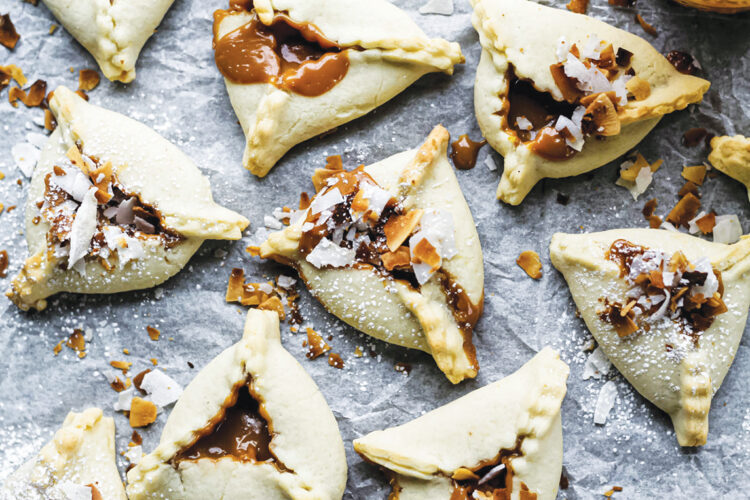Dulce de Leche Hamantashen

Rethinking the South American alfajores cookie for Purim.
By Leanne Shor, The Nosher
Alfajores are a decadent sandwich cookie filled with dulce de leche, a caramel-like spread made from condensed milk. Most people associate alfajores with Argentina, Uruguay, and Peru; they were brought to the New World by the Spanish in the 16th century. Before that, it’s said that the cookies were actually an Arab import when Spain was largely under Arab control in the 14th and 15th centuries.
 I was first introduced to the famous South American cookie at the well-known Israeli café chain Aroma in New York City. Alfajores are actually extremely popular in Israel today, much more so than in the States.
I was first introduced to the famous South American cookie at the well-known Israeli café chain Aroma in New York City. Alfajores are actually extremely popular in Israel today, much more so than in the States.
Making your own dulce de leche filling is actually incredibly easy, but if you can find it at your grocery store, feel free to use it here.
For the dough:
2/3 cup butter, room temperature
3/4 cup granulated sugar
2 large eggs, room temperature
1 tsp. vanilla extract
2 tsp. freshly grated lemon zest (zest from 1 lemon)
2.5 cups unbleached all purpose flour
1/2 cup cornstarch
1 1/2 tsp. baking powder
1/2 tsp kosher salt
For the dulce de leche filling:
2 14 oz. cans sweetened condensed milk
1/4 tsp. kosher salt
1/2 tsp. vanilla extract
To serve:
1 cup unsweetened large flaked coconut (Preferable to the heavily sweetened macaroon coconut)
1/4 cup powdered sugar
Remove the labels from both cans of sweetened condensed milk. Place the cans on their sides in the bottom of large pot. Fill the pot with water. Bring the water to a boil, then lower the heat and simmer for at least three and a half hours. Add water if necessary, so that the cans are completely submerged in water. Use tongs to remove the cans from the hot water, and allow the cans to cool for least one hour.
Open the cans and scoop out the caramelized dulce de leche. Add the salt and vanilla extract, and whisk to combine thoroughly. Set aside.
In a medium-size bowl, whisk the flour, cornstarch, baking powder, and salt. In the bowl of a stand mixer, combine the butter and sugar. Cream on medium speed until lighter in color and fluffy.
Add the eggs and lemon zest and thoroughly combine. Add the flour mixture to the bowl of the mixer, and beat on low speed until the dough comes together in a ball, about one minute. Dump the dough out onto a large piece of plastic wrap, bringing it together into a ball, then flatten with your hands. Wrap the dough tightly, and refrigerate for at least 45 minutes.
Preheat the oven to 350 degrees. Line a baking sheet with parchment paper. Place the coconut flakes on the baking sheet, and toast until lightly golden brown, about eight to 10 minutes. Pour the coconut into a bowl, and set aside.
Cut the dough in half. Dust your work surface with flour. Working with one half, roll the chilled dough out to quarter-inch thickness. Use a 3-inch round cutter to cut out as many circles as possible. Re-roll the scrapes and repeat with the second half of dough.
Place a teaspoon of filling in the center of each circle. Fill a small bowl with water, and dip your finger in and run it around the perimeter of each cookie. This is the glue that will hold the dough together.
Pinch the top of circle together, then bring up the bottom of the circle, creating three distinct points. Pinch the corners tightly, and up the sides very tightly, enclosing the filling, so it doesn’t spill out. Dulce de leche is a softer filling, so a tight seal is important.
Place the shaped cookies two to three inches apart on the prepared baking sheet and place the cookies in the freezer for 15 minutes to help maintain their shape.
Bake the cold cookies for 12-15 minutes until the edges are slightly golden brown. Remove from oven and sprinkle with toasted coconut and powdered sugar.
To read the complete March 2022 Dayton Jewish Observer, click here.

